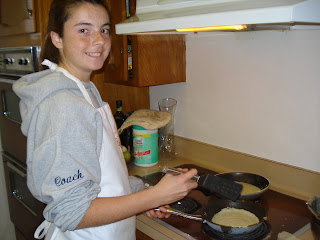For many of these entries I might begin with, “one of my favorite foodie films,” but this one actually is my favorite--Pixar’s Ratatouille. If you haven’t seen it and like food, or have kids, or you are a closet Francophile, watch it immediately. Why is my favorite on the food movie list a computer animated film? A host of reasons. I love the artistry--the pink glowing images of Paris. I love the story and main theme, “Anyone can cook.” I love that the villain’s nickname is “The Grim Eater” (and that he becomes a ‘good-guy’). Finally, I just love the food.
A few best quotes:
“-You're slow for someone in the fast lane.
-And you're thin for someone who likes food!
-I don't like food, I love it. If I don't love it, I don't swallow”
“Humans don’t just survive. They discover. They create.”
“We are artists, pirates. More than cooks are we.”
For this favorite, I wanted to do something special, to share the movie and the cooking with people I thought would enjoy it most. I asked family friends if I could come over and watch Ratatouille with their three wonderful daughters. We ended the movie with a French cooking project, in part inspired by the title recipe (ratatouille), and in part by the cuisine in general (dessert crepes).


(Posing with Remy's Ratatouille)
To prepare, I had to find a very untraditional Ratatouille recipe, like the one Remy cooks for the scary critic Anton Ego. Luckily throughout this process of food film cooking, I have discovered that a large online community of bloggers, cooks, and food film buffs has already done a lot of the work for me. As far as I know, I think I’m the only one compiling this many on-screen recipes, but I am lucky to have a wealth of sources. I decided to combine two recipes. The first is for
Confit Byaldi, the model dish for the film created by The French Laundry Chef Thomas Keller. This is a complex dish with a piperade and vinaigrette, probably too difficult to start with during a kids cooking lesson. I also used a less complex
recipe I found from Smitten Kitchen, a food blog I stumbled onto. The dish is very impressive for the minimal amount of fuss, really just chopping and arranging. Here’s what we came up with (the recipe below makes 2 rounds):

Remy’s Ratatouille
Tomato base:
½ onion, finely chopped
2 garlic cloves, minced
Salt and fresh ground pepper to taste
2-3 tablespoons olive oil
1 can peeled, crushed tomatoes
1 tablespoon lemon juice (optional--one of the girls made this suggestion, and it adds tangy twist to ratatouille)
Sautee the onion, garlic, salt and pepper in olive oil until golden (not fully browned). Add the crushed tomatoes and simmer, stirring for a few minutes. Stir in lemon juice. Pour the sauce evenly to coat two shallow, round baking dishes.
Layered Vegetables:
1 eggplant, 1 red bell pepper, 2 small zucchinis, 2 small yellow squashes, 6 roma tomatoes
salt and fresh ground pepper to taste a few pinches thyme

Remove the ends of vegetables and core of the red bell pepper. Cut the vegetables into slices, as thin as possible.
In one baking dish, top the tomato base with a layer of eggplant. Add a few slices of bell pepper.
Atop the eggplant and bell pepper layers, arrange the slices of vegetables concentrically from the outer edge. Alternate vegetables and repeat (ie. 1 slice zucchini, then squash and tomato) until you reach the center. Add a slice of red bell pepper to

the center for garnish. Add pinches of salt, pepper, and thyme.
Repeat the layering process for the second baking dish. You will have extra bell pepper. Finely chop a few slices for a vinaigrette (below).
Cover the dishes with parchment paper, cut to fit. Bake for 45-55 minutes at 375 F. The tomato sauce should be bubbling, and the vegetables not entirely limp. Remove from oven to let rest as you prepare:


(our ratatouille steamed just like in the movie!)
Secret Sauce
(the girls really liked the secret idea--this one’s up to you, but I threw this together)
1 clove garlic
2 tablespoons olive oil
¼ cup finely chopped onions
splash of white wine
2 tablespoons balsamic vinegar
Reserved chopped bell pepper
salt and pepper
Sautee onions, garlic and bell pepper for about 4 minutes. Add wine, vinegar, and salt and pepper

to taste.
Top each serving of ratatouille with a spoonful of the secret sauce, and try a handful of grated parmesan cheese. The dish would work well with pasta.
As the ratatouille baked, I taught the girls how to make crepes. When I was around eight years old, I absolutely loved French food. I created my own ‘restaurant’ in our breakfast nook called “Leelee’s Bistro.” I went all out, researching recipes, and even created laminated menus (which I still have) of gourmet food. For my parent’s anniversary and my sister and now brother-in-law’s graduation I gave each couple a dinner at my restaurant. I remember using the fine china and purple velvet placemats, and learning how to officially set a table. My favorite dish from my restaurant was dessert crepes, and with the girls, I used the same worn out, splattered copy of a recipe from a children’s cookbook that I used as a child. My crepe-making method of pouring out excess batter is probably not the most chef-y way to do things, but this dish for me has always been more fun than serious.
Dessert Crepes
4 eggs
2 T. sugar
1 c. flour
1 c. milk
¼ c. water
1T. melted butter
Whisk the eggs in a bowl. Add sugar. Alternately whip in milk and flour. Mix in water. After melting the butter, slowly add to the batter while whisking. Chill the batter for 1 hour.

Lightly grease your pan (made for crepes, or just a small frying pan). Heat the pan on medium heat. Remove the pan from heat and pour in a few tablespoons of batter. Quickly swirl the batter around the pan, so that the bottom is covered. Pour out excess batter (this will give you a little flap on the side of the circular crepe to help flip). Set the pan back on the burner and cook over medium heat. When the crepe is light brown, carefully flip to brown the other side. Remove from the pan and repeat.
Filling ideas -- this is my favorite part of crepe making and a good way for kids to experiment in the kitchen. I brought over several crepe dishes to try out different flavor combinations:

sliced apples and caramel sauce
sliced strawberries and nutella
sliced bananas and nutella
blackberries and lemon juice
Place fillings in the center of the crepe (it is easiest to spread your sauce first and then add fruit).
Gently fold over one side and roll up your crepe. Place the crepe seam side down.
For the sliced apple crepes, I placed them under the broiler to soften the fruit and caramelize the sugar.
Top crepes with chocolate sauce and whipped crème. Voila!
___________________________________________________
Whenever I watch Ratatouille (and I’ve seen it many many times) my favorite part is the critic’s reaction. After eating Remy’s ratatouille masterpiece, Ego has a flashback to his childhood, when his mother made him the comforting soup. In this cooking day, I definitely had one of those flashback moments, as I am sure I will continue to have in my screen to table month. Cooking was a major part of my childhood, and I always dreamed of having a restaurant. Food has a way, maybe it’s all the senses involved, of reminding us of the best of times.
After the enlightening meal, Ego writes this essay on criticism:
"In many ways, the work of a critic is easy. We risk very little, yet enjoy a position over those who offer up their work and their selves to our judgment. We thrive on negative criticism, which is fun to write and to read. But the bitter truth we critics must face is that in the grand scheme of things, the average piece of junk is probably more meaningful than our criticism designating it so. But there are times when a critic truly risks something, and that is in the discovery and defense of the new. The world is often unkind to new talents, new creations. The new needs friends."
The quote may be from a pixar movie, but it has substance. I hear the funny villain with the pointy nose say this, and I think of the critics who hated impressionists, and of course, film critics. Food and film have much in common. Both are creative processes that require inspiration and lots of work. Both are created for the eventual appreciation by an audience, and with an audience comes the professional critic. I am skeptical of many critics. The regular film critic for my local newspaper always makes me angry with his unnecessary distaste for anything popular. Then again, there are critics who encourage us to experience the new, fresh creations, like Remy’s Ratatouille. These are the critics to celebrate.
Final note: I would like to thank the Komar girls for their enthusiasm and expert help in the kitchen! Keep up the cooking.































